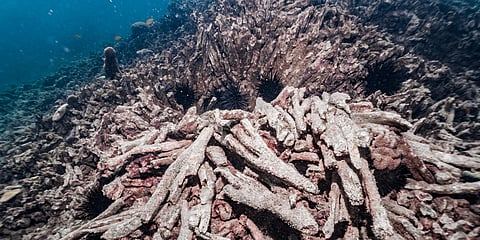

The ongoing fourth global coral bleaching (GCBE4) event that began in January 2023 is now the most widespread and surpassed the coral bleaching levels of 2014-2017 by over 11 per cent, according to the United States National Oceanic and Atmospheric Administration (NOAA).
The record breaking, severe and intense global bleaching event has been recorded in almost half the amount of time than the previous event.
During the three years of GCBE3, over 65.7 per cent of the world’s coral reefs were exposed to bleaching level heat stress and it was registered as the longest, spatially widest and most damaging event on record.
At least 77 per cent of global reef areas have experienced bleaching level heat stress in almost 20 months as part of GCBE4.
Derek Manzello, coordinator of NOAA Coral Reef Watch, told Down To Earth that the emergence of La Niña should bring respite to many regions and lead to declines in the percentage of reef areas being impacted.
“But more localised coral bleaching events will likely still continue,” he said.
In the past six weeks alone, Palau, Guam and Israel have confirmed bleaching. While heat stress continues to remain high in the Caribbean and South China Sea.
Manzello explained that strong El Niño events have historically been the harbinger of severe bleaching events, but recently, large-scale and severe events have occurred during La Niña periods (Great Barrier Reef in 2022; Fiji and Vanuatu in early 2023).
“This suggests that ocean temperatures have increased to the point whereby large-scale bleaching events may now occur during any phase of El Niño-Southern Oscillation (ENSO),” he added.
ENSO is a recurring climate pattern involving changes in the temperature of waters in the central and eastern tropical Pacific Ocean.
Manzello said that roughly 99.9 per cent of the coral reef areas in the Atlantic Ocean have experienced bleaching-level heat stress during this event.
This implies that nearly every coral in the North and South Atlantic Ocean has experienced some level of thermal stress since this event began and many areas of the Caribbean are seeing a second year of extreme heat stress right now, he said.
“We have confirmed reports of mass coral bleaching from 74 countries/territories since February 2023 and this includes locations in both the northern and southern hemisphere of the Atlantic, Pacific, and Indian Oceans,” he noted.
However, the full scale of its impact may not be known until a few years of the event as scientists would require extensive in-water monitoring and in-depth field assessments in impacted areas. Manzello said such assessments are generally completed months after a bleaching event has stopped.
Once the follow up surveys are done to quantify mortality and recovery, those data then need to be analysed and interpreted, he explained.
During extreme marine heatwaves, coral mortality can start to occur rapidly in the most heat-sensitive species in a matter of days-to-weeks, Manzello further said.
“However, the full ramifications of a bleaching event really aren’t known until 1-2 years after the marine heatwave has subsided. This is because corals can still die for 1-2 years after bleaching because they become immunocompromised by the heat stress and thus become far more susceptible to disease-driven mortality,” he said.
Citing an example, Manzello said during the 2005 bleaching event in the US Virgin Islands, many corals survived the heat, but then went on to die from subsequent disease outbreaks over the next two years. These subsequent disease outbreaks drove a 60 per cent decline in coral cover (Miller et al. 2009, Coral Reefs).
“There is already one publication from this event from the Mexican Pacific, where they documented between 50-93 per cent mortality of corals in the Huatulco region of Oaxaca. Furthermore, we do know that there has been severe mortality of elkhorn and staghorn corals in certain locations of the Caribbean; however, it will be some time before we have a true, holistic vision of the impacts of these species across the region,” he said.
Considering the wide-scale record coral bleaching, scientists the UN have called for a special emergency session on coral reefs during the Convention on Biological Diversity summit (COP16) in Cali, Colombia.